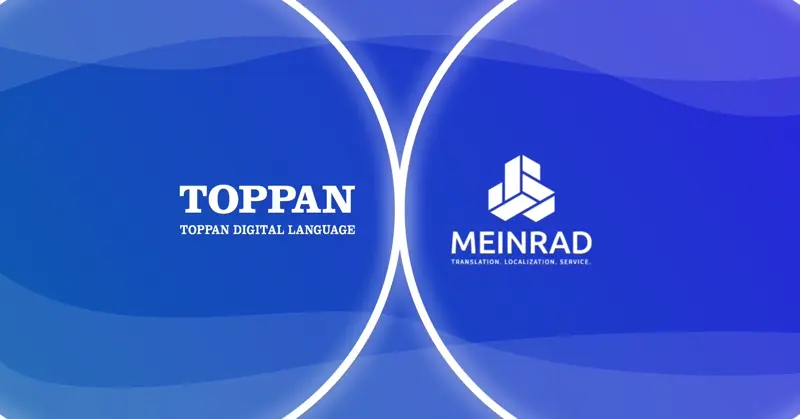
In summary: Our Chief Strategy Officer, Alexandra Jarvis, highlights the top 10 trends to look out for in 2024 in the language industry. This includes security and data privacy, onshoring practices, braille, TMS migration, Machine Translation Post-editing, synthetic voice and AI transcription, LLMs, mixed modalities, AI regulations, and M&A activity.
In 2023, the language industry witnessed groundbreaking technological advancements. ChatGPT 3.5 ‘came out of nowhere’ and, with other LLMs, delivered major steps forward in natural language processing – bringing this field of AI to the attention of many new business users.
The technology landscape is evolving at a fast pace, and it may be presumptuous to make predictions for a whole 12-month period. However, we humbly offer our views on the top 10 trends we think will impact the language services industry in 2024. These include not only AI but other ways in which the industry will be challenged to enhance its services, technology offerings, and operating models to meet evolving client needs.

Security and Data Privacy
The exponential growth in digital data has placed security and privacy in the limelight. Companies, particularly those in regulated industries, are not only seeking advanced encryption and secure data handling practices but also exploring how AI can play a role in enhancing data security.
This trend is especially pertinent given the rise of privacy regulations such as GDPR, HIPAA, and PIPL and the ways in which companies wish to manage their data risks within these frameworks. This means Language service providers (LSPs) are faced with the challenge of adapting their operational and technological set-up to meet their customers’ specific needs.

Onshoring
In a world where data sovereignty is becoming increasingly important, some clients now prefer their data to be processed within their geographic boundaries, often due to legal and privacy concerns. This “onshoring”, meaning that services are fully delivered within a national border represents an operational shift in the language industry.
This trend impacts technology, project management, linguistics, and other production capabilities. LSPs will need to recalibrate their strategies, focusing on local talent pools and establishing region-specific operations to meet this type of requirement.

Braille
Accessibility in language services is gaining momentum, particularly in the USA, and Braille is an important emerging category. In the US, Section 508 Standards have long championed accessibility. In addition, the health equity framework by the Center for Medicaid and Medicare Services has called for proactive fulfillment of language access needs, including braille. It’s no longer enough to have braille literature on demand.

TMS Migration
The Translation Management System market is in the early stages of a major replacement cycle. As older systems reach end of life, customers will be faced with decisions about what they want from a next-generation TMS.
This replacement cycle will not just be a technical upgrade but can potentially be a strategic shift towards more agile, automated, and integrated platforms. We predict that the definition of TMS will change much more towards a multi-service management platform.

Machine Translation Post-Editing (MTPE)
MTPE’s evolution marks a paradigm shift in machine translation. No longer seen as just an advanced form of translation memory, MTPE now involves intricate processes where human expertise intersects with AI efficiency.
The focus is increasingly on refining the output through skilled post-editing, ensuring that the translations meet the nuanced demands of context and culture.
Moreover, with AI’s growing role, MTPE is being scrutinized under the lens of AI ethics and reliability, making quality assurance more crucial than ever. Watch out for the phrase “ethical AI” in 2024.

Synthetic Voice and AI Transcription
The advancements in AI-driven audio processing provide new opportunities in fields like dubbing and transcription. Synthetic voices are becoming more natural and versatile, enabling more authentic and engaging localized content.
However, this technology brings its own set of challenges, such as managing the intellectual property rights of synthetic voices and maintaining quality in sensitive applications. We expect strong progress in these areas in 2024 but acknowledge that human supervision will be required to assess where AI is mature enough for production use.

MT + Large Language Models (LLM)
The combination of Machine Translation and Large Language Models is creating a new frontier in language technology. This trend is less about replacing human translators and more about augmenting their capabilities.
For instance, LLMs are being used to improve the accuracy of MT outputs, assist in training more sophisticated models, and streamline the management of linguistic assets. The collaborative interplay between MT and LLMs will open up exciting possibilities for enhanced translation quality and efficiency.

Mixed Modalities
The concept of mixed modalities is taking the industry by storm, with LSPs leveraging a combination of AI technologies to create innovative language solutions. This trend involves using AI not just in textual translation but in interpreting visual and audio content as well.
A notable example is visual recognition AI. It can be used to translate and create multilingual product descriptions from images. These multimodal approaches are redefining the boundaries of translation services, offering more comprehensive and integrated solutions.

AI Regulation
As AI becomes more entrenched in the language industry, regulation will emerge as a key consideration in 2024. Governments and international bodies are starting to draft guidelines and frameworks to ensure the ethical use of AI.
This regulatory environment will dictate how AI technologies are developed, deployed, and managed in the language industry. Compliance with these regulations will be crucial for LSPs, impacting everything from novel AI model development to commonly deployed MT technologies.

M&A Activities
The language industry has long been reshaped through mergers and acquisitions (M&A). Indeed, at TOPPAN Digital Language, M&A is a major part of our growth and investment strategy.
However, more widely, it is evident that some of the buy-and-build M&A activity in the industry that was primarily focused on financial engineering has been curtailed owing to a higher cost of capital and some waning interest from private and public investors who are concerned about AI.
In this context, we expect M&A to become more of a strategic tool for repositioning in response to market changes and technology shifts. We also predict that it will make sense for some LSPs to simplify their businesses, including through disposals.
So, there you have it! It’s always fun to think ahead for the next year. We would have never predicted quite what transpired in 2023, but at TOPPAN Digital Language, we’re committed to keeping you informed and engaged with these developments, ensuring that our tailored solutions and insights help you stay ahead in this ever-evolving landscape. We look forward to checking back in throughout the year.














